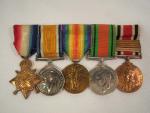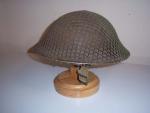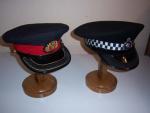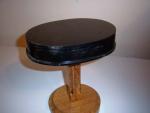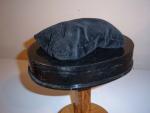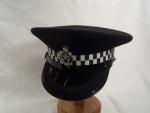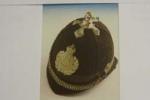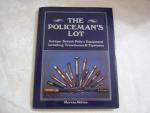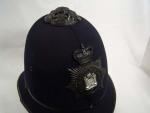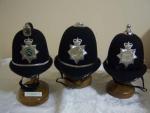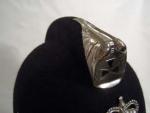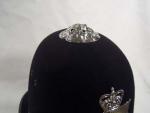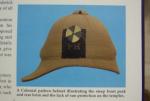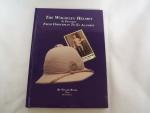-
Posts
6,486 -
Joined
-
Last visited
-
Days Won
10
Content Type
Profiles
Forums
Blogs
Gallery
Events
Store
Everything posted by Brian Wolfe
-
I would like to comment that this is an excellent thread, lots of information and very educational. This is what I would like to see more of on the forum. Many thanks for starting this thread Tim and thanks to others who are adding to it. Well done. Regards Brian
-
Quite interesting Mervyn. Thanks for posting them, I trust there are more to come? Regards Brian
-
I was going through my Police collection cabinet and thought you might like to see this unresearched group. I do have a fondness for groups that include a Special Constabulary Medal. The 1914/15 Star, BWM and Victory Medal are all named to: 17429 CPL. A.W. TAYLOR SUFF. R. (Suffolk Reg.) The Defence Medal is, as usual, unnamed but the Special Constabulary Long Service Good Conduct Medal is named to: ARTHUR W. TAYLOR. Regards Brian
-

EK 1914 EK1 screwback to pinback conversion
Brian Wolfe replied to Eric Stahlhut's topic in Germany: All Eras: The Iron Cross
Hello ERic, Excellent workmanship on the conversion, was this conversion to a horizontal pin as uncommon as I think?. A really nice EK1, thanks for posting it. Regards Brian -
For police helmets I use 1/4 sawn white oak, the same as the police forage caps, but for my military headgear I use red oak. This decision is only because I like both white and red oak but didn't want to mix the two woods in my collection so it's white oak for police and red for military. God, I am so anal. The only difference between the police and military helmet stands is in the top piece which I use hard maple. This particular maple is "spalted" (a natural stain which can be used decoratively in cabinet work). I use maple as oak has tannic acid and I don't want that in contact with the headgear. The top is finished with several coats of clear. One could pad or cover this sipport but I don't, at least for now. I like what you have done Chris. I just preferred to have the headgear on pedestal-style stands and besides I like to make things. Regards Brian
-
Hi Chris, I'm blessed with an abundance of scrap hardwood so I've made my stands in my own shop. For the police headgear I've used 1/4 sawn white oak with a pine top to support the forage caps. The pine block is cut in an oblong shape in the correct size for the cap it will support. Front to back measurements for the block happens to be the same as the hat size (7 1/8 size cap = 7 1/8 inches for the block. At first I was making this out of one piece of wood but that became a bit too much work so now I cut the block out of pine and attach a thin piece of plywood to the bottom for the cap's edge to rest on. The reason I am fussy about the size is that the peek of the cap will not wrap to the correct shape if the block is too small. I don't make the block as wide as a natural head to allow air to circulate inside the cap through the spaces at the cap's sides. The block is finished with a couple of coats of black enamel paint to seal the wood and to hide the plywood cap edge support from view. The oak is finshed with several coats of clear coat. All of the pieces are dowelled together (I hate screws and nails) with 1/2 inch hardwood dowels. To imitate the top of the head I use felt pillows filled with sand. When a forage cap is worn the top of the head causes a bump, without this the top may sag on the display stand and not look "right". I'll show the helmet stands in the next post. Regards Brian
-

Camberwell police
Brian Wolfe replied to Tony's topic in Great Britain: Mervyn Mitton's British & Colonial Police Forces
Hi Mervyn, I think you are spot on thinking this is a retirement ceremony. I would think they would have been of quite high rank considering there was a band on hand. Regards Brian -
Stuart I'm still looking into why there are three different styles so I can't give you an answer yet. All of the top-pieces are vent covers and the sides of the helmet have two holes on each side to assist with the ventiliation. I'll try to post photos of the ventiliation when I get back home this afternoon (your morning). I was also intending to do a short write up regarding the construction of the custodian helmet as well so perhaps I'll attempt both in the same post. Regards Brian
-
Very impressive collection Mervyn. It's not something you usually think about when talking about the early years of British policing. Thanks for posting them. Regards Brian
-
There seems to be a love/hate by British Police Officers both past and present regarding the wearing of the custodian helmet. I've read posts on another forum that some love the helmet while other hate it. Some say it is outdated and uncomfortable to wear and should be discarded. Others say that is gives them an easily recognizable symbol for the public as well as other officers. Some hold to tradition while others claim to be wanting to move on to be in step with more modern times. I would really like to hear from past and present police officers on this topic and of course I'd like to see any headgear in your collections whether you are a police officer or not. Thanks for reading through this very long post, I hope you felt it worth your time. Regards Brian
-
In the past custodian helmets, or ones very similar, were worn by the police forces of Australia, Canada, New Zealand and the United States of America. Outside of the United Kingdom today the custodian style helmet is still in use by some Italian Municipalities while the officer is directing traffic. Most countries discontinued the use of custodian helmets when the officers were issued automobiles rendering the custodian helmet difficult to wear in the vehicle. To my knowledge the custodian helmet, in the United Kingdom, is worn only while on foot patrol. The helmets were replaced by the now familiar forage cap. I have included two examples of forage caps here. One is from Staffordshire and the other from Peel Region Police Services here in Ontario Canada. I know the Canadian example is out of context for this topic but it is only to show the similarities even though most reading this post will already be aware of that. Please only post British headgear in this section and forgive my transgression of the proposed conventions.
-
An early helmet that deserves mention here is the Glamorgan Helmet of the early 1900s. This is a rare helmet and quite sought after by collectors. It featured a metal chin strap that could be slung across the top of the helmet. This helmet is not one that graces my modest collection so with kind permission from Mervyn, from his book, the following photograph was taken.
-
A variation of the custodian style helmet was the "Noddy" that was used for a short time on the Velocette (motorcycle) of the 1960s era. This helmet was strenghtened and had a cork lining to add more protection for the Velocette rider. These also have a sturdier leather chin strap. These were soon replaced, (as were the Velocettes), with a helmet similar to the motorcycle helmet commonly seen in use today.
-
I offer this suggestion (last page) as a source to the design that influenced the custodian helmet, however, this is not to say that this is the only, nor even correct, answer to the question. As always this post is meant as a platform for discussion. If other members would like to weigh in with their theories and opinions please feel free to do so, you views are always welcomed. Today we see three styles of custodian helmets in use, the comb (or coxcomb), the boss (or rose) and the ball top. The comb style is the most common with 21 out of the 43 police forces in the Home Office Territorial Forces of England and Wales using the comb style. This is followed by 18 using the boss style and only 4 using the ball top style.
-
I would like to start this topic of British Police Headgear off with a discussion of the Custodian Helmet and it is with hope on my part that other members will add to it. It is the intention that in time all forms of British headgear will be dicsussed and displayed here. The most easily recognizable and iconic piece of police headgear in the world has to be the British Police Helmet. The Bobbies helmet of more correctly, the custodian helmet, as we know it today, was developed around the turn of the last century. Prior to the custodian helmet, the headgear worn by British Police resembled a top-hat. The reason for the top-hat design was to prevent the police force from being mistaken as a Para-military group. One account that I have read suggests that the design for the custodian helmet was influenced by another iconic piece of headgear, the German Pickelhaube. I'm not convinced of the German pickelhaube connection. As a fellow member of the GMIC and the author of the book, "The Policeman's Lot" by Mervyn Mitton, states on page 118 of his book, "The top-hat was worn for 34 years, but, in 1863, a new style was tried experimentally, based on the military helmet of that period, and from 1865 this became the standard headgear". In support of this hypothesis I offer the work of another author, also a member of the GMIC, Stuart Bates, who states in his book, "The Wolseley Helmet In Pictures From Omdurman to Alamien", by Stuart Bates with Peter Suciu, the following. "The origins of the Wolsely helmet are shrouded in mystery although it appears, on the photographic record, first in the 1896-98 campaign in the Sudan". To my way of looking at this the Wolsely helmet certainly was designed before the suggested date by the photographs of 1896-98, therefore the design dtae for the custodian helmet has a military contempory already in the United Kingdom upon which to base the design, without the need to use the German pickelhaube as inspiration.




